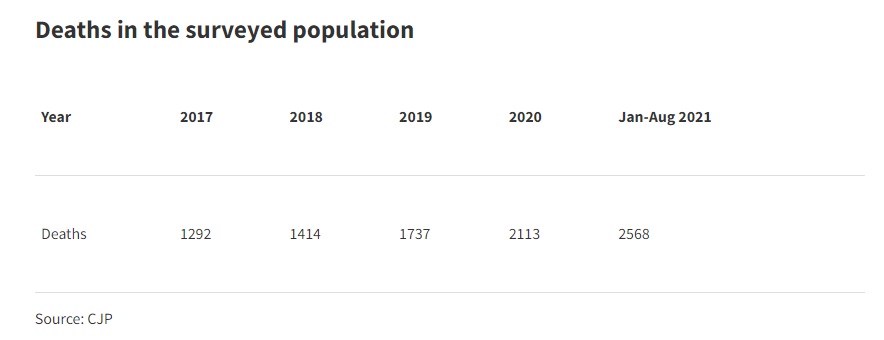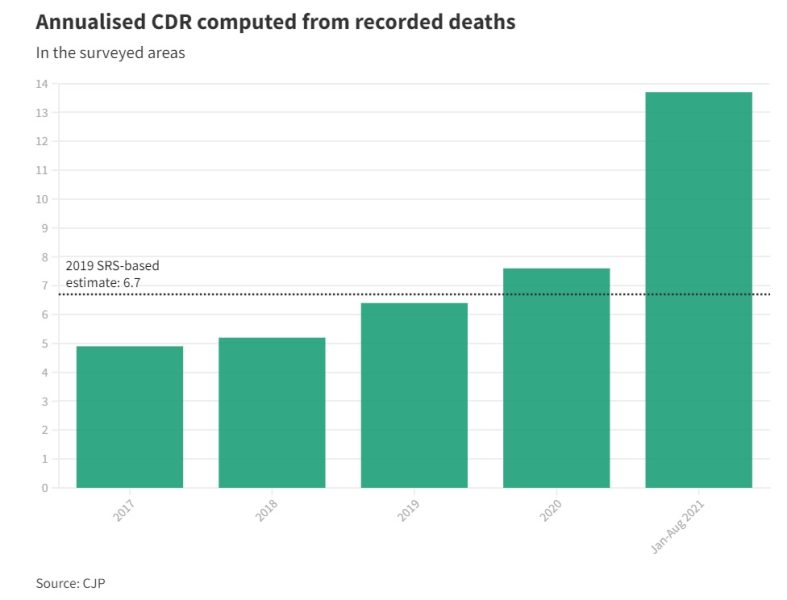
As UP votes, report details COVID’s deadly toll on state

As Uttar Pradesh elects its next government, a new report has emerged shedding light on the deadly toll of COVID in the state.
Data collected and analysed by Citizens for Justice and Peace (CJP), a human rights organisation, and independent experts reveal that Purvanchal – home to Varanasi, Prime Minister Narendra Modi’s constituency – witnessed a distressing increase in deaths between January 2020 and August 2021.
The areas surveyed saw around 60 per cent more recorded deaths than expected from 2019 records as well as from government data before the pandemic, according to the CJP.
The CJP published the report first in partnership with the news website The Wire. Murad Banaji, a mathematician with an interest in disease modelling, contributed to it. Teesta Setalvad, secretary of the CJP, shared the report – which is available here in full – with The Federal.
The report said if the rise in mortality in the surveyed areas was repeated across all of Uttar Pradesh, the state as a whole could have had around 14 lakh excess deaths during the pandemic – roughly 60 times the official COVID toll of 23,000.
In November-December 2021, the UP team of CJP started collecting records of deaths from 2017 to August 2021, as maintained by local offices in villages and urban areas in the Purvanchal region. The organisation said it obtained complete records from 129 areas, largely in Varanasi and Ghazipur districts.
“A basic analysis of this data reveals a big spike in recorded deaths in 2020-2021 compared to previous years as well as to expectations based on government data on Uttar Pradesh’s death rate,” it said.
“While not all deaths can be conclusively attributed to COVID-19, it is reasonable to conclude that the pandemic played a key role in the huge increase in mortality.”
The team visited local offices, gram panchayats and crematoria and burial grounds, and sought the help of village heads and secretaries, as well as ASHA workers. In many areas, CJP said, it was unable to access any data – either because death records were not maintained or because they were not shared.
The 129 areas that were taken into consideration, in the final analysis, had an estimated total population of around 2.8 lakh in 2021. Of them, around 43,000 people resided in urban mohallas and the remainder were in rural areas. That is, the surveyed population was roughly 85 per cent rural – an approximate reflection of UP as a whole.
The dramatic increase in deaths came from both rural and urban areas, the report said. Deaths in rural areas during the first eight months of 2021 were double that expected from the 2019 data – and around 80 per cent higher than that expected.


The surveyed areas had 55-60 per cent more deaths during the 20 months from January 2020 to August 2021 than expected in this period. Across UP, a 55-60 per cent surge over 20 months would amount to around 14 lakh excess deaths in this period, according to the report.
Based on Sample Registration System and civil registration data, the state “expects to have around 15 lakh deaths in a normal year. The pandemic excess death toll would then amount to almost a full year’s extra deaths in the state”, it said.
“Another perspective on these stunning numbers is that 14 lakh people amounts to around 0.6 per cent of Uttar Pradesh’s estimated 2021 population, of around 23 crore. This means 0.6 per cent of the state’s population possibly lost their lives prematurely as a result of the pandemic,” it said.
The report compares UP with Andhra Pradesh, which has reliable civil registration data available and which has reported the highest pandemic excess mortality in India. Estimated excess deaths in AP amount to a little over 0.5 per cent of the state’s population, it said.
“Our survey thus suggests that when it comes to pandemic mortality, Uttar Pradesh could be worse-hit than Andhra Pradesh – and possibly the hardest-hit state in the country,” it said.

